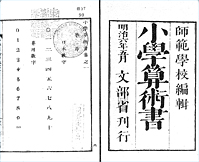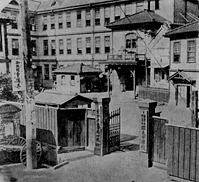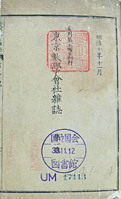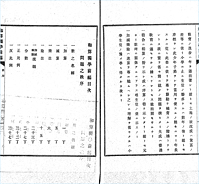Chapter 6. Epilogue: End of Wasan
(1) Disappearance of "Wasan" and "Wasan scholars"
When the Edo period ended and the Meiji era began, Japan started to promote modernization in all possible fields, in imitation of the West. Particularly, while science and technology education prominently showed such a tendency, the Ministry of Education developed guidelines regarding elementary education and promulgated them as part of the school system in the fifth year of Meiji (1872), implementing elementary education in the following year.
As to arithmetic education within the overall elementary education, the Ministry set forth a policy of employing a curriculum not based on conventional Wasan but based on Western arithmetic or Yosan ("Yo" means western and "san" means arithmetic or mathematics). Exceptionally, it was decided that only the soroban would continue to be used as a calculation tool because there were no good alternatives. Once this new school system was implemented, Wasan would fade from the classrooms in public education. However, when reconsidering this situation, we should contemplate who actually taught the Yosan to children when the new elementary schools began to be established across the country.
At the beginning of the Meiji era, many arithmetic textbooks and guidelines for teachers were published. When studying them, we understand that they only included very elementary subjects. Looking at the matter from a different angle, we can assume that there would have been many in Japan who could have taught the subject at elementary schools if they had studied elementary Yosan. This means that many of those who knew the conventional Wasan and many Wasan scholars taught at elementary schools in the Meiji era. Of course, this was a transitional phenomenon; schools for training elementary teachers related to normal schools were established all over Japan, and when graduates from such schools started to teach at elementary schools, Yosan education by teachers who had received purely modern education was thoroughly established. In this way, the social role borne by Wasan scholars began to diminish with each passing year.
In the academic fields, Wasan was ending its role in the process of modernization of Japan. In the 10th year of Meiji (1877), the Tokyo Mathematical Society, the first academic society related to mathematical science in Japan, was established by volunteers. This was the forerunner of the Mathematical Society of Japan. Looking at the membership structure of the early society reveals that Wasan scholars or those who had received education influenced by Wasan in the last days of the Tokugawa regime accounted for the majority, while those who had fully studied Western mathematics or scholars who were teaching Western mathematics were relatively few. The generations that received education through Western mathematics accounted for a greater share of the membership with each passing year, and by the end of the Meiji era, Wasan was regarded as completely obsolete.

Shogaku sanjutsusho in the early Meiji era
NDL Digital Collections
Fukuda Riken, a Wasan scholar, who was also excellent in Yosan, established a school after the Meiji Restoration, which has now become a senior high school (the picture was taken in the Taisho era).
Junten gakuen 55 nenshi: Junten gakuen, 1990 <FB22-E481>
(2) Conversion to Yosan
As indicated by history, it looks like the 200-year old tradition of Wasan was simply forsaken from the arithmetic and mathematics of Japan. we wonder if those involved in Wasan did not feel a lingering affection for Wasan when faced with such a situation. Some Wasan scholars voiced a frank feeling of discomfort against the permeation of Yosan. However, they could not change the trend of the times that would introduce the Western mathematics that supported the foundation of science and technology. Rather, we could take the following viewpoint: Wasan scholars who had also studied Western mathematics from the last days of the Tokugawa regime to the beginning of the Meiji era were those who noticed the value of mathematics as a practical science ahead of others in Japan. As described earlier, if they had followed a view that mathematics should be useful as a practical science for society, it should have not mattered to them whether it was of Wasan or Yosan origin, as long as it was useful. Actually, as those who promoted the introduction of Yosan also studied Wasan, not all the Wasan scholars were opposed to Yosan. In other words, we could even say that the conversion from Wasan to Yosan was an inevitable move in the wake of the entire policy change regarding science and technology, viewing it from the perspective of practical science .

Uchida Itsumi, who was a member of the Tokyo Mathematical Society, played an active part in the introduction of the Gregorian calendar and was chosen as a member of the Tokyo Academy.
Lager image for Tokyo sugaku kaisha zasshi
Tokyo sugaku kaisha zasshi
(3) Wasan that survived in regions
Lastly, we would like to introduce the fact that Wasan played a role in contributing to regional education even in modern times. we explained previously that Wasan completely disappeared from classrooms in public education; nevertheless, mathematical education through Wasan continued to exist in some parts of the Tohoku and Chubu regions in private juku schools up to the Showa era. Why did such a thing happen? The prewar compulsory education system was only up to elementary school. Therefore, there were many people who had to give up school education for various reasons even if they wished to continue. It was Wasan juku schools deployed in the rural areas that satisfied the intellectual interest that some such people had in the mathematical field. Even in the Meiji era, Sangaku (mathematical tablets) were dedicated to shrines and temples all over Japan. we think this is a very interesting example demonstrating the existence of Wasan education as a supplementary area of study to modern education.
Wasan supported people's daily lives and played a role in satisfying their intellectual curiosity. we think that the roles Wasan can play will also be reconsidered in the future, in the context of each successive era.

Wasan Dokugaku 1, released in the 34th year of Meiji, which states that it was compiled to be generally intended for some children who would not attend education beyond elementary school due to residence or low income
NDL Digital Collections


